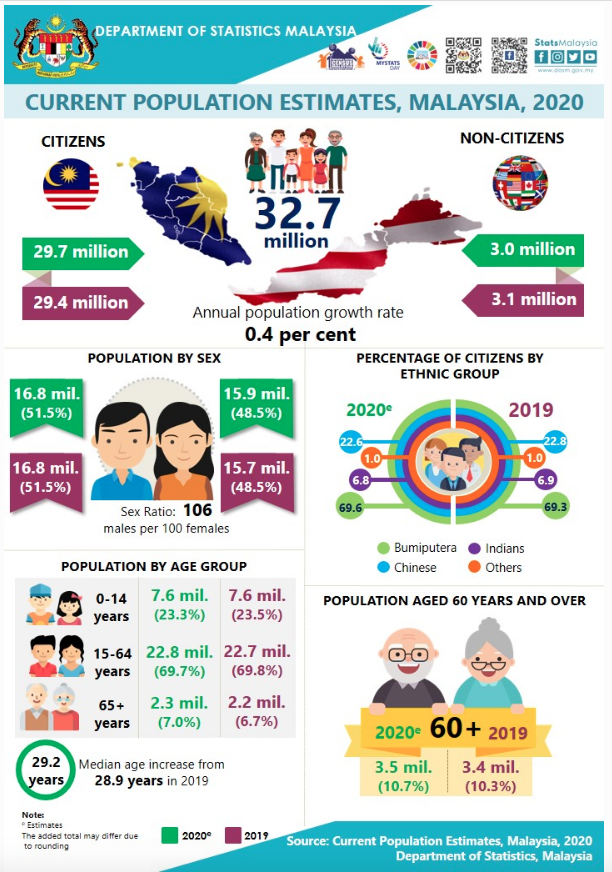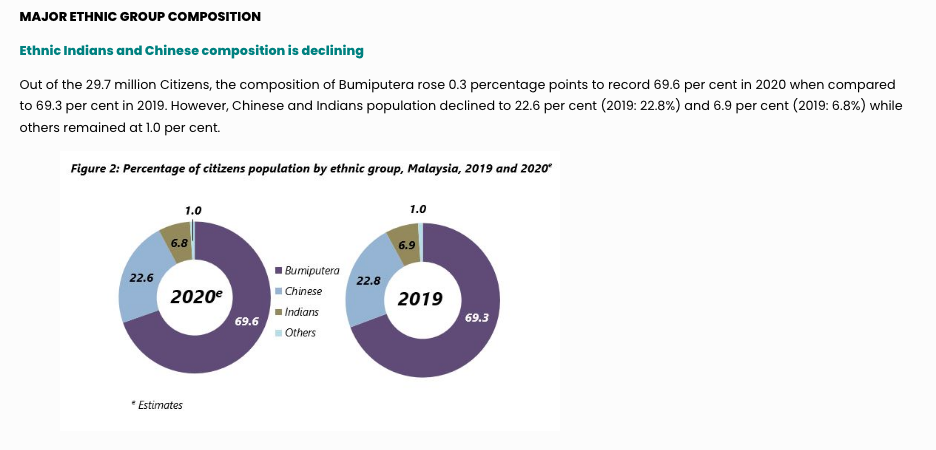
Census 2020: Bumiputera population increases to almost 70pct while that of the Chinese and Indian ethnicities have reduced
The percentage of Bumiputera in Malaysia’s population has increased to 69.4 per cent while the Chinese and Indian ethnicities make up less than 30 per cent, according to the recently concluded National Census 2020 exercise.
It also showed that Malaysia’s population has increased to 32.4 million people, compared to 28.3 million in the 2010 census of which 67.4 per cent were Bumiputera while almost 32 per cent were people of Chinese and Indian ethnicities.

a slight increase is reflected in the existence of non citizens Photo credit Department of Statistics Malaysia
This has brought about various comments on social media about the change in status of the various ethnic groups.
A Facebooker who goes by the name of Lim Sian See said that he recently came across some Chinese language propaganda that is inciting the Chinese that the reason why the percentage of the Malaysian Chinese population as stated in the latest 2020 government census is due to policies that favour the Bumiputra and are disadvantageous to the non-Bumiputra.
The Chinese Population
“While I admit that there are policies that give certain advantages to the Bumiputra (which Pakatan Harapan also never abolished while in government despite their rhetoric and decades of race-based incitement + propaganda), the main reason why the Chinese population is decreasing as a percentage of Malaysians is really due to us Chinese, our culture and our lifestyle – not government policies. If you look at the world’s birth rate by country, the countries mostly hugging the bottom of the list with the lowest birth rates are mostly the wealthy mono-ethnic Sino countries.

“And these countries do not have Bumiputra policies since they are largely mono-ethnic. Rank (out of 228 countries) and births per 1,000 population:169 China 11.30 (due to abolishment of their one-child policy)202 Singapore 9.13217 Hong Kong 8.23223 Taiwan 7.43224 Japan 7.00226 South Korea 6.89. Malaysia is ranked at 120 with 14.72 births per 1,000 people. As a country becoming increasingly wealthy and a greater emphasis is placed on children education and personal lifestyle/enjoyment, the Sino or oriental population tends to marry later in life, choose not to marry or have fewer children,” Lim added.
Apparently, democracy is brutal.
He reminded the Chinese Malaysians: “You still only get one vote during elections whether you are smart or stupid, whether you are rich or poor or whether you are Malay, Indian or Chinese, that is the nature of any democratic country.”
On another note, Minister in the Prime Minister’s Department Mustapa Mohamed said that the average Malaysian household size is shrinking.
The size of the average Malaysian household has shrunk over the past 10 years, revealed the latest population and household census by the Department of Statistics.
Mustapa said according to the 2020 Malaysia Population and Housing main findings report, the national average household has dropped to 3.8 persons in 2020 from 4.3 in 2010.
He said the latest census showed Kuala Lumpur and Penang recorded among the lowest average household sizes with 3.5 persons.
He did not rule out the cost of living may affect the average household size in Kuala Lumpur and Penang as compared to the situation in Kelantan and Sabah.
Cost Of Living
“Cost of living may be among the factors (which contributed to the low average household size in Penang and Kuala Lumpur).
“We could not do a complete analysis. Generally, if we are residing in a city such as Kuala Lumpur, it will be difficult to stay in an apartment with only two bedrooms if we have many children,” he said.
Among other highlights of the report included the growth of the population which increased by 1.7 per cent as of 2020.
“This is something that we need to pay attention to since we are a nation that still needs manpower (among the younger generation) for the country to prosper,” said Mustapa,
“During the last census conducted in 2010, our country’s compounded annual growth rate (CAGR) was more than two per cent,” he said.
It took 482 days to complete the process due to the pandemic, which complicated matters because of its alternating phases.
Dr Mohd Uzir Mahidin, the chief statistician at the Department of Statistics Malaysia, reported that about 99.2 per cent of the population took part in the census, which cost RM400 million.
Overall, there are 8.2 million households with an average of 3.8 members. The data show a slight sex imbalance (101 men for every 100 women), but in Putrajaya, the country’s administrative capital, the ratio is 96 men for 100 women.

In terms of age groups, the distribution is among the most sustainable of Asia: 24 per cent is under 14, 69.3 per cent belongs to the productive age group, while 6.8 per cent are 65 and over. – New Malaysia Herald
Datin Hasnah is the co-founder and CEO of New Malaysia Herald based in Kuala Lumpur, Malaysia.
With an extensive background in mass communication and journalism, she works on building up New Malaysia Herald and it’s partner sites. A tireless and passionate evangalist, she champions autism studies and support groups.
Datin Hasnah is also the Editor in Chief of New Malaysia Herald.

Facebook Comments